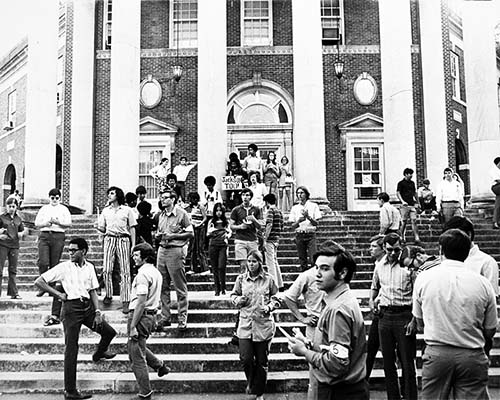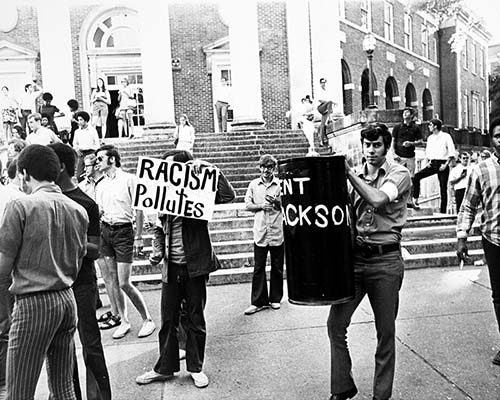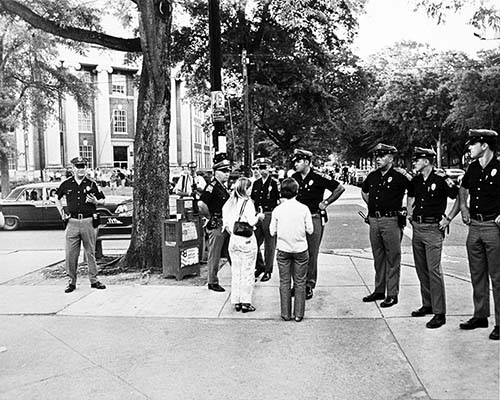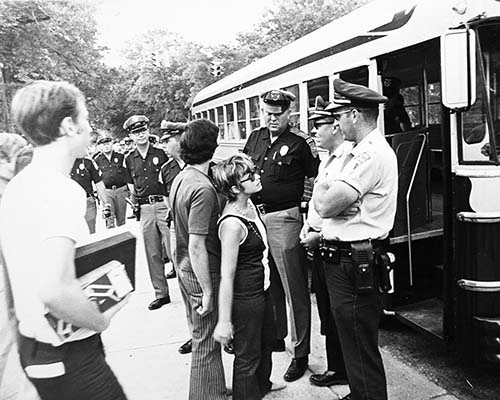And I feel myself a cog in somethin’ turning
“Woodstock,” Joni Mitchell
And maybe it’s the time of year
Yes and maybe it’s the time of man
And I don’t know who I am
But life is for learning
Another shooting
When police fired on protesters at Jackson State College (now University) in Jackson, Mississippi, on May 14, it was only 11 days after the incident at Kent State. It was also only 200 miles — about 3 hours by car — from Tuscaloosa.
Students at the historically Black institution were demonstrating in response to the news that Civil Rights leader Charles Evers had been killed — a rumor that later proved false. Flanking a main road that ran through campus, they threw rocks at drivers, overturned vehicles, and set fires.
Just after midnight, members of the Jackson police and Mississippi Highway Patrol were attempting to clear a crowd outside of one of the women’s dorms when they began firing. They later claimed to have been responding to shots from a sniper, although evidence of one was never found.
Twelve were injured and two killed: Jackson State student Phillip Lafayette Gibbs, 21; and local high school student James Earl Green, 17.
For more on the incident, see Whitney Blair Wyckoff, “Jackson State: A Tragedy Widely Forgotten,” NPR, May 3, 2010.
Another memorial
A memorial was held on Monday night for the lives lost at Jackson State. Students marched from the Student Union to Denny Chimes, this time escorted by campus police and State Troopers. As they had nearly two weeks before, they lit candles and settled in on the Quad for some time to ruminate on events. This time, the crowd was far smaller, perhaps 150-200 people.
The event was supposed to be held in the Student Union ballroom, but while the SGA agreed to this restriction, the SFC had continued to press for an outdoor venue. So police eventually asked the students at the Chimes to disperse or return to the ballroom (or, alternatively, to go to Foster Auditorium). They did return to the Union, stopping on the steps to taunt the police with chants of “Pigs! Pigs! Pigs!” before being driven into the building.
New forms of resistance
After an hour or so, the students emerged again and attempted to return to the Quad. State Troopers on hand to prevent this were met with a novel protest tactic: students asking to be arrested. They simply showed up at the law enforcement bus and tried to get on; if they did not desist after some calm and friendly discussion, they would be taken into custody.
“This is the nicest group of people we ever arrested,” said one trooper, smoking a cigarette casually in the dark.
Dolph Tillotson, “Options Exams are Suggested”
In turn, the arrests were peaceful. As one student put it later, “The police have treated us like gentlemen.”
All in all, 41 students were arrested by State Troopers. The city police were not called in, and there was no repeat of May 13-14.
A quiet end
Hours before the memorial, Pres. Mathews had already encouraged the University’s deans to consider optional final exams. It was not a de facto closure of the school, Mathews insisted, but a way of recognizing the “plight of serious students who found themselves prevented from adequate preparation for their exams as a result of campus unrest.”
The conversation around resistance tactics did not end, but as the semester fizzled out, so did the unrest. Thankfully, there had been no loss of life. As an instructor is quoted in the Tuscaloosa News as saying,
“You’ve got to survive. Whatever you do, don’t be a martyr. Your martyrdom won’t make as much difference as you may think.”
These events at the University of Alabama and our remembrance of those lost at Kent State and Jackson State somehow both disprove and support this theory. Six deaths changed the country; the fact that no one died in Tuscaloosa may have helped change it, too.
Sources
“Woodstock,” written and performed by Joni Mitchell, was released on Ladies of the Canyon, April 1969, and as a single in March 1970, the B-side to “Big Yellow Taxi”
Secondary
- Earl H. Tilford, “May 1970: Days of Rage and Reason,” Turning the Tide: The University of Alabama in the 1960s, Tuscaloosa: The University of Alabama Press, 2014, pgs 190-208.
Primary
- Dolph Tillotson, “Optional Exams Are Suggested by Dr. Mathews,” Tuscaloosa News, May 19, 1970, pgs 1, 2.



